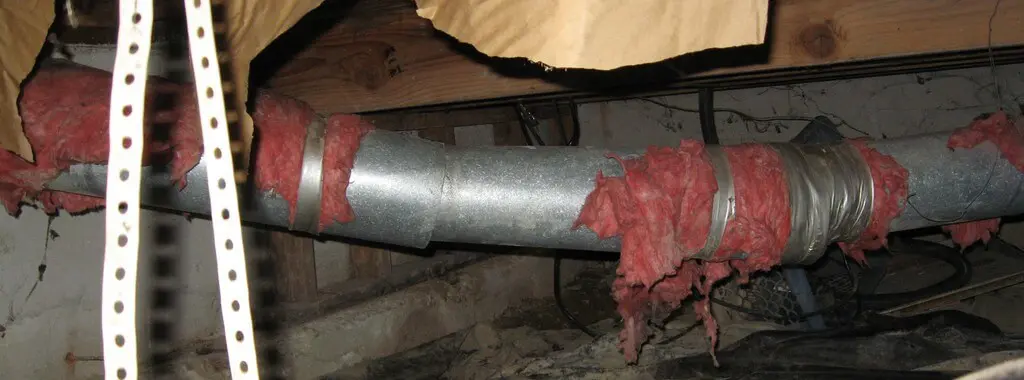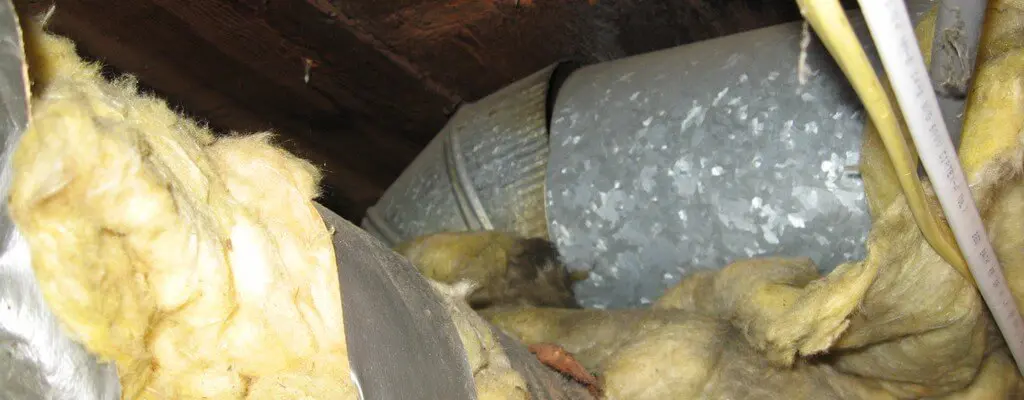Crawlspace Ducting Issues
Crawl space ducting is presented with an interesting challenge. It is tasked with taking clean, filtered air and delivering it through a very unclean environment (the crawl space). When the ducting fails to achieve this goal, the consequences can be significant. In this article, we’ll discuss the common problems and solutions for crawl space duct issues.
The primary goals of crawl space ducting:
- Maintain the cleanliness of the air.
- Maintain the warmth of the air.
Maintaining clean air.

Improper Ducting
The first goal is achieved by maintaining properly sealed ducts. In the old days, this was accomplished with duct tape. Initially, this worked well and provided a tightly sealed air delivery mechanism. However, over the years contractors began to find evidence of material failure. In short, with sufficient time, duct tape loses its adhesion and allows air to pass through. Unfortunately, many HVAC companies still use duct tape because the problem only arises long after their gone.
Fast forward a few decades and now many municipalities now require mastic instead of duct tape. While much messier to work with, mastic offers far more durability. Even in areas that don’t formally require mastic, any proactive HVAC contractor uses the material. Certainly, any home trying to reach a high degree of energy efficiency will use mastic. Once applied, it looks like a thick, goopy, grey paint. You’ll find it on all major joints and seams.
Maintaining warm air.
Broadly speaking, HVAC contractors use three primary techniques to maintain the warmth of the air. The first two are far more common and comprise 90% of homes using crawlspace ducting.
- Insulation applied to rigid ducting.
- Insulated flexible ducting.
- Sealed / heated crawl space.
Until recently, crawlspace ducting was composed of rigid galvanized steel sheet metal. After installation, the insulation contractor wrapped the ducting with fiberglass. This technique has several advantages. First, the rigid ducting is far more durable than flex ducting and if kept dry will last many decades. Second, rigid ducting can be easily cleaned, while flex ducting cannot. Duct cleaning is rarely recommended, however, so this attribute is not especially important.
Flex ducting has dramatic advantages as well. Because the line of ducting comes from the factory in one continuous piece, the number of air leakage points is minimal. The only potential air leakage points and heat loss points
Project Report > Inspection for Ducting Issues in Crawlspace
Weather
- Overcast and raining
General
- Temperature:
- Outside: 39 degrees F
- Main Floor: 69 degrees F
- Relative Humidity (RH):
- Outside: 68%
- Main Floor: 44%
- Mold growth can occur when the relative humidity levels range 65% to 99% in a given environment. If you keep the humidity low enough, you can prevent mold growth. Maintaining relative humidity below 50% inhibits mold and mildew growth, dust mite infestations, and bacteria. This lower relative humidity also reduces the out-gassing of volatile organic compounds (VOCs).

Broken Ducting in Crawlspace
- Carbon Monoxide (CO):
- Outside: 0 ppm
- Main Floor: 0 ppm
- Ideally, CO concentrations indoors are expected to be the same as CO concentrations outdoors. CO concentrations are typically around one to two parts per million parts of air (ppm) or less. Concentrations are usually lower in rural areas. Finding CO concentration higher indoors than outdoors indicates an indoor source of CO, or a source very close to your home.
- Carbon monoxide is an odorless, colorless gas often formed in the process of incomplete combustion of organic substances, including fuels. CO can cause serious health problems.
- Carbon Dioxide (CO2):
- Outside: 442 ppm
- Main Floor: 551 ppm
- The American Society of Heating, Refrigerating and Air-Conditioning Engineers (ASHRAE) recommends a concentration of CO2 no more than 700 ppm above the ambient air (outside) concentration in order to minimize human odors and maintain comfort.
General Notes:
- Mid-century rambler with obvious upgrades over the years.
- 2×6 tongue and groove subfloor, 4 ft centers.
Main Floor
- Air sample taken in dining room as a central location.
- Walls and ceiling were scanned using a thermal imaging, infrared camera to determine any areas of temperature differential which would indicate moisture intrusion, missing insulation and/or other structural defects. No areas where temperature differentials indicated an area of concern.
Crawlspace
- Crawlspace did have ventilation but was primarily located around back of home.
- HVAC ducting had either poor insulation or none at all.
- HVAC ducting contained many areas where air leakage was occurring.
- Standing water was present throughout the crawlspace – primarily under the vapor barrier.
- Vapor barrier was in good condition throughout.
- Sump pump was present in crawlspace but appeared to not be functioning at time of inspection.
RECOMMENDATIONS
- Recommend having sump pump replaced to control groundwater in crawlspace.
- Recommend having all insulation removed from HVAC ducts and seal all joints with high-velocity mastic.
- Reinsulate all HVAC ducts after mastic dries.
- Recommend having R-38 insulation installed throughout the floor cavity.
- Contact Environix if a quote is requested on insulating and sealing air ducts and floor cavities.
*Heads up – I earn a small commission on sales through Amazon links. This helps cover the expense of running the website (and answering your questions!)
